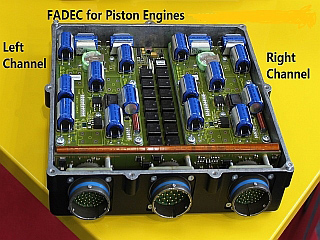Aviation Words - FADEC
October 2015 - How many of you still drive a stick-shift car with a choke control? It’s been a long time since I did. You may remember that a choke is a device to enrich the mixture to enable start-up and early warming of the engine. Once you push the choke in, you lean the mixture to the normal operating position. If you drive a car with a choke you probably also have an ignition coil and a distributor.
In aircraft we have the additional problem of altitude, so getting the mixture right is a little more complicated. Most of us probably still fly an aircraft with a mixture control and a carburetor, but aircraft engines are getting more and more sophisticated, especially on the control side.
FADEC for piston engines
Full authority digital engine control (FADEC) uses the principle that has long been in use in our automobiles—that the engineers know better than we do on the exact control settings for the specific circumstance. In the same way we use only the foot-operated throttle in our cars to control the engine, the FADEC takes over all the work of adjusting engine parameters based on that one user input, throttle setting. All the other ambient inputs like air pressure and temperature are acquired automatically. FADEC is implemented with devices that can be controlled digitally (the “D” in FADEC), so it implies that you are using electronic ignition and fuel injection. They control not only fuel flow and mixture but also ignition timing and many other parameters.
In the same way that our cars are a lot more reliable and fuel-efficient today, FADEC is the way forward for light-aircraft engines, for the identical reasons. Look around at exhibitor booths at air shows. Almost all new engine advances are based on FADEC including the newer diesel advances. Another acronym, “ECU” or Engine Control Unit, is a component of FADEC. Since ECUs are the core of FADEC, they are capable of sending the engine information they acquire directly to electronic displays. An example of this is the Italian MWFLY ECU’s ability to send all engine data over just two wires to the Dynon SkyView. The most accessible and promising version of FADEC is available on the Rotax 912 iS engine, and reports suggest that fuel savings of 15-20 percent or more are possible compared with the same engine without the benefit of FADEC. The 912 iS is also capable of using Ethanol 10, MoGas, or Avgas. Although the engines are built in Germany, the parent company, Bombardier Recreational Products (BRP), is a Canadian company, so just one more reason to consider Rotax for your next project.
As well as efficiency, the technology also brings simplicity and safety. No risk of carburetor icing, no need to adjust mixture with altitude changes, no need to change mixture settings for landing and takeoff. The benefits are numerous.
Many of us will be considering FADEC as a key component of our next engine choice. Will you?

